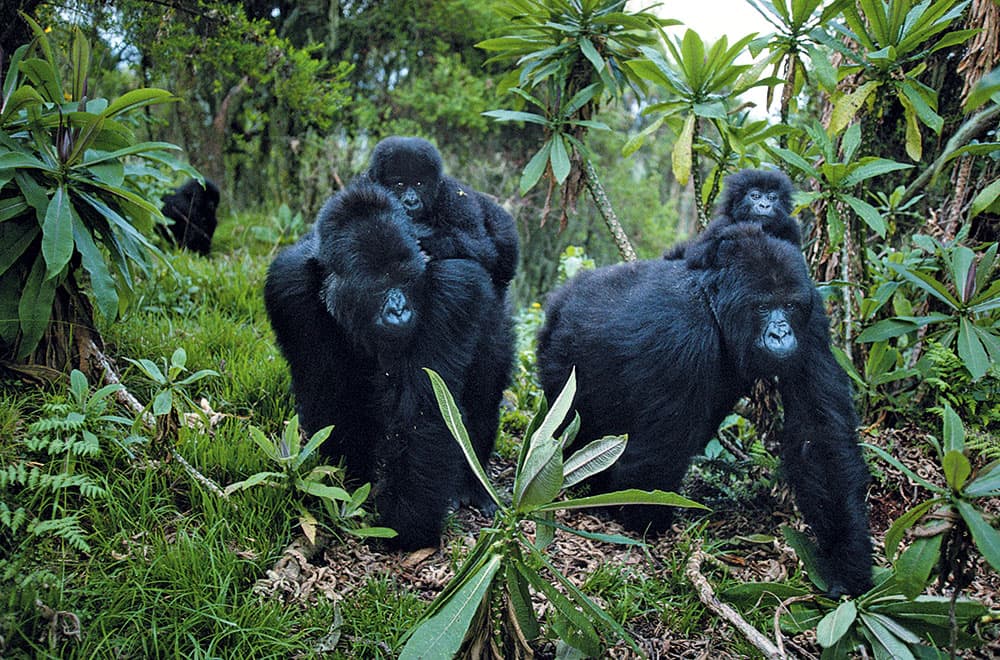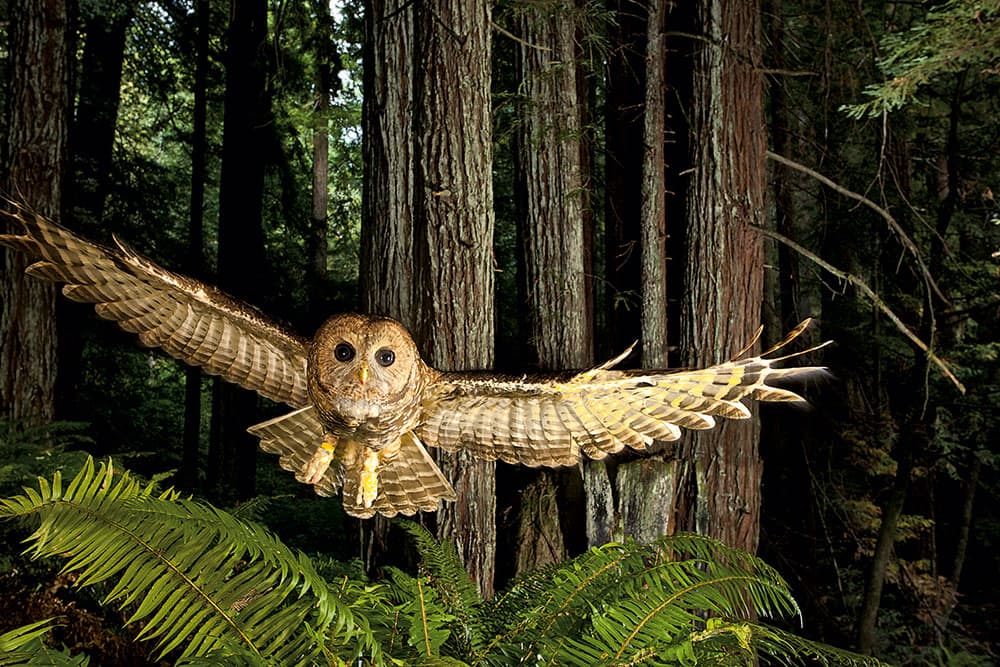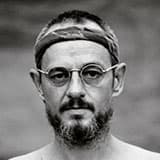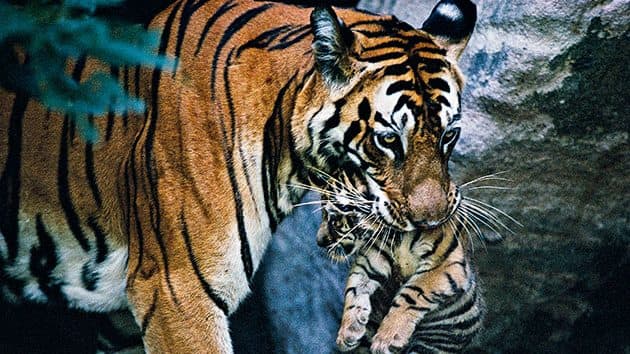With a career that stretches back almost 40 years and a new biography, Michael Nichols is in a reflective mood. His smooth Alabama drawl comes down a phone line from his Virginia home as he admits, “I never thought I would have a biography but I thought I would do a retrospective called A Wild Life.
“I’ve just had a big museum exhibit in Philadelphia – one of the great art museums in the United States. They’ve never exhibited a photographer like me in any way and we’ve mixed my photographs with its permanent collection and added masterpieces that have something to do with the natural world.”
Michael Nichols has been documenting this world since the late 1970s in a career that saw him join the Magnum agency in 1982 and then National Geographic in 1996, from which he retired as editor-at-large in 2016, following a final assignment in Yellowstone National Park.
In his early days he was better known as an adventure photographer – noted for photographing spectacular caves and famously dubbed ‘The Indiana Jones of photography’ by Paris Match – but this quickly developed into something deeply rooted in conservation issues and the realisation that the power of his photography could change the minds of key decision makers.
He explains: “It’s very interesting where we are with wildlife right now, so the [book] title works on many levels. The [Philadelphia] exhibit was called ‘Wild: Michael Nichols’, so I’m playing with the word wild because I don’t think humans really get it.
“We like tame much better than we like wild [laughs]. Even people who really love animals really like them to be kind of cute and fuzzy; they don’t want them to be really wild and dangerous.”

Mountain gorillas, Volcanoes National Park, Rwanda, 1995. Credit: Michael Nichols/National Geographic Society
Awareness of conservation
When quizzed on what was the key trigger that sparked his awareness of conservation Nichols shoots back, “My time with Magnum really helped that because when I came into Magnum, Philip Jones Griffiths [the agency’s then president] was the most high-minded person I’d met.
“Philip was a pain in the ass – he was very judgemental, but he was the one who saw my work and encouraged me to join Magnum. I came into Magnum as a colour photographer who used flash to photograph adventure stories and I’d just done a little bit of wildlife, photographing gorillas. But Philip saw something in me that meant ‘he’s gonna grow and become serious’.”
Nichols returns to the awareness question and says, “If you’re asking about a moment that I saw that [conservation possibility], it was with mountain gorillas as a young man. In 1980, when I photographed them, they were going to disappear and I thought, ‘Wow, we get something with these pictures that’s bigger than just a magazine story.’
“Once I got on that path, I really never got off. When you do something like that you’re no longer working or worrying about assignments – you’ve got a mission. Once you’ve got a mission it gives you something to really put your heart and soul into. The fact that photography can change the world is a big deal. It can do it like no other medium – even a video doesn’t do what photography does.”

Jane Goodall and the chimpanzee Gregoire, Brazzaville Zoo, Republic of Congo, 1995. Credit: Michael Nichols/National Geographic Society
Major projects
Since the ‘conservation fire’ was lit in Nichols he has traversed planet Earth shooting more than two dozen projects, with his trusted Canon SLR cameras not far from his side, and often taking months or even years to finish a project. Regular National Geographic readers will be familiar with his work with animals – chimpanzees, lions, tigers, elephants and more – as well as projects such as the MegaTransect walk across Africa, his documentation of the battle to save redwood forests in California and his final National Geographic project in Yellowstone National Park.
But, perhaps surprisingly, Nichols admits, “The most important person in my life was my art teacher when I was a kid because she said, ‘You don’t have to be a carpenter or a car mechanic – you can be an artist.’ Where I grew up [in Muscle Shoals, Alabama] was middle class and you were taught to have a trade, but she said. ‘No, you can be creative’… and then my Mom doing the same thing was reading to me all the time.”
He continues, “But going into my career… [primatologist] Jane Goodall was my hero before I met her. Jane was always so dignified… I’m a wild kind of character and she taught me to care about the individual. She was very pointed with me, saying, ‘Nick, what if we change one person’s mind and they’re the one who changes the world?’ That’s where you make the difference but I was always for the masses and I still do believe that you’ve got to have both.”
Nichols has often worked closely with highly driven, often difficult, people such as Goodall, ecologist Mike Fay, zoologist Iain Douglas-Hamilton, tree scientist Steve Sillett and orphan-elephant experts the Sheldrick family.
He reveals, “None of these people pander to photographers – they barely f**king tolerate us but they want you to come because then their work [gets noticed]. Me coming with National Geographic… they wanted me there but after a few days they just want you to go away because you’ve taken some pictures, but I’m like ‘No. I’m here! You asked me to come and I’m not going away.’ By the end they would always feel that I gave them as good as I got – it’s an equal exchange.”
Nichols adds, “But it can be incredibly frustrating to work with maniacal people. Even the wonderful Jane Goodall is not Jane Goodall because she’s passive – she’s going to get her way. That’s what all these characters do and I found a way to work with them and tell their stories to the world. It was worth it, but it’s painful – you don’t go through that without emotions, without scarring.”
A Wild Life: A Visual Biography of Photographer Michael Nichols (Aperture, ISBN 978-1-59711-251-2, priced £25) is written by Melissa Harris and features the photographs of Michael ‘Nick’ Nichols.
Embracing technology
While the vast bulk of his career was spent shooting on transparency film, Nichols has always been swift to adopt the technologies of the digital age. “I got a good taste of digital – the stuff I did with lions was some of the best work I ever did and that required all that technology and all the things digital would let you do.
“Every time that technology would move I would embrace it. I’m not technical so I like to have an assistant who is young and can read all the manuals. Nathan Williamson has worked with me for the past ten years – and he was a kid who would build a ham radio as a six-year-old, so you know what you’ve got there.”

C-Boy (shot in infrared non-visible light), Serengeti National Park, Tanzania, 2012. Credit: Michael Nichols/National Geographic Society
The state of conservation
It seems churlish not to ask Nichols for his thoughts on the state of conservation today and he’s glad the subject is raised. “The thing that freaks me out right now is to have a [US] president talking about that it’s better to have guys working in coal mines, in dead-end jobs that are never going to go anywhere, instead of working in renewable energy. We have a moral imperative right now. Climate change and nature are not just about what we want today – it goes back.
“When you have a 1,500-year-old tree or a 3,200-year-old tree, if you think of what’s happened on the planet in the lives of those trees, all of this ‘carbon footprint’ that we talk about and man’s real impact on the planet has happened in that time. Those trees have been standing during that whole time of Man’s impact and we’ve got to back off.”
He continues, “We’ve got to realise it’s not about animals – it’s about a moral imperative. It’s about the world and it’s about whether you take care of your nest.”
Nichols adds, “I believe that photography is probably the strongest tool in making people get that on an emotional level and we have all the policy people who can follow it up with substance. That’s really the sum of my career because I’m after the visceral response of the viewer.”

Northern spotted owl, Humboldt County, California, 2008. Credit: Michael Nichols/National Geographic Society
The future
With a recent knee replacement bedding in and his time currently being taken up publicising his biography, as well as two major exhibitions, I ask what’s next? “If I do something else I don’t know what it is yet. I might just stare out into space.
“I don’t feel like I have to do more. I’m not… [like] Jane Goodall and Mike Fay – they will continue till they take their last breath, but my photography required so much that I don’t have any more. I think I’ve burned up all that I had. I’m not embarrassed about it. People worry about me and they think I’ll just die, but right now I’m having fun for the first time.”
 Born in Muscle Shoals, Alabama, in 1952 Michael Nichols began his career as a US Army photographer. After leaving service he worked for GEO magazine and in 1982 joined the Magnum agency. In 1996 he joined National Geographic as a staff photographer and became an editor-at- large in 2008. He spent two years documenting the MegaTransect expedition, crossing 2,000 miles of Congo forest on foot. He has won numerous prizes for nature and environment stories. Visit www.michaelnicknichols.com.
Born in Muscle Shoals, Alabama, in 1952 Michael Nichols began his career as a US Army photographer. After leaving service he worked for GEO magazine and in 1982 joined the Magnum agency. In 1996 he joined National Geographic as a staff photographer and became an editor-at- large in 2008. He spent two years documenting the MegaTransect expedition, crossing 2,000 miles of Congo forest on foot. He has won numerous prizes for nature and environment stories. Visit www.michaelnicknichols.com.








